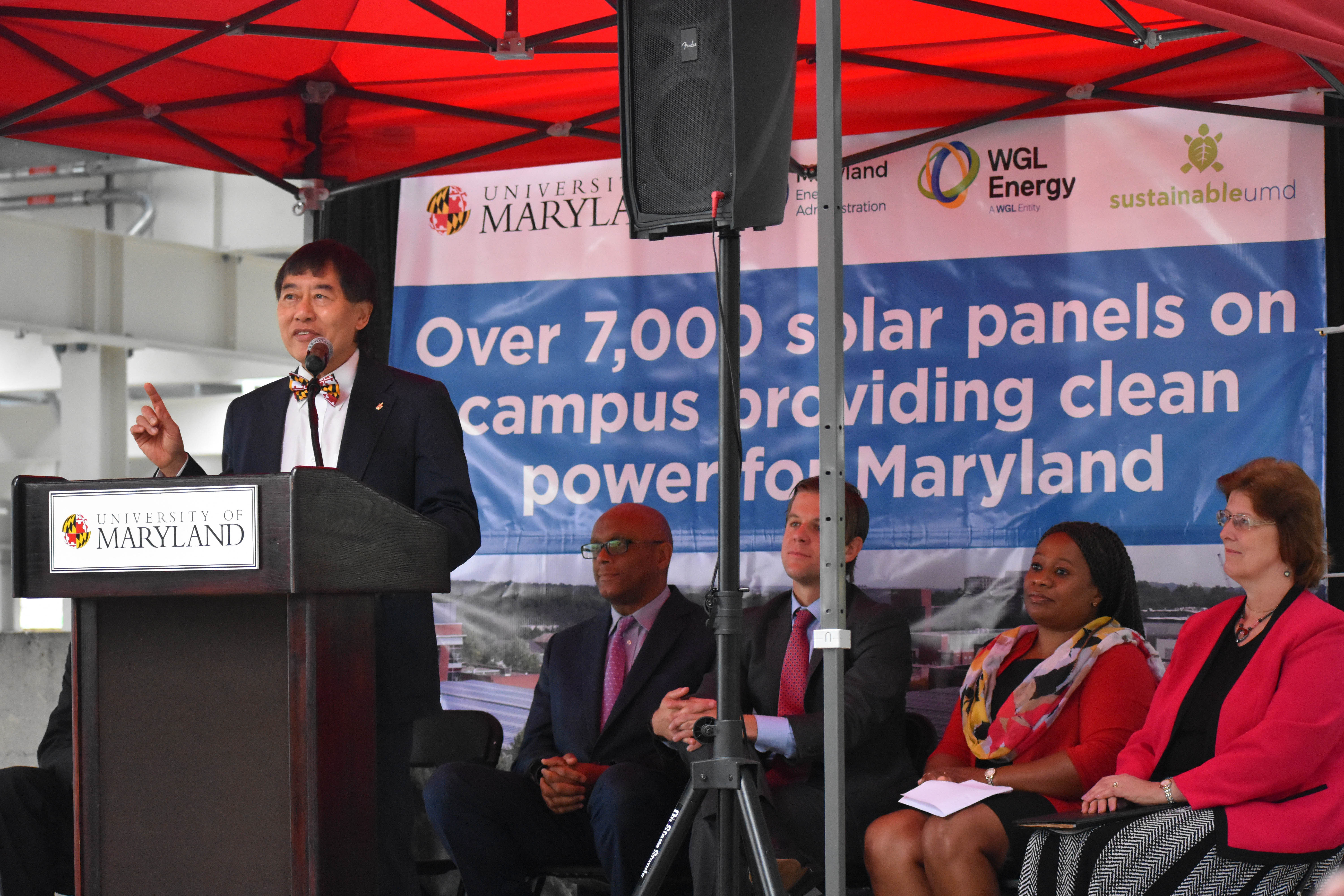University of Maryland representatives, private businesses and state government officials gathered on Wednesday to celebrate the construction of more than 7,000 solar panels on top of campus parking garages.
The solar canopies were installed over Regents Drive, Terrapin Trail and Mowatt Lane parking garages during the summer, and commenced operation on Sept. 18, according to a press release from Andrew Muir of this university’s Office of Sustainability.
The solar power generated from the project will amount to a little more than two megawatts of renewable energy, making it one of the largest solar facilities in the D.C. area.
Held on the top level of Regents Drive Garage, the ceremony drew about 60 people and featured several guest speakers involved with the project. University President Wallace Loh spoke to the crowd about the importance of environmentally friendly energy production in a time when he said the Trump administration is neglecting environmental health.
[Read more: A nonprofit ranked UMD the second-most sustainable Big Ten school]
“Even though our federal government may be skeptical about continuing in the Paris Accords on climate change, we in our local communities can still make a lot of progress regardless of what happens in Washington, D.C., and this is an example of it,” Loh said.
“Just the notion of driving up this ramp to the rooftop of a garage and seeing that there is an energy generation facility here — that is absolutely incredible,” he added. “That is what innovation is all about.”
The project was a joint effort between this university’s engineering and energy department in Facilities Management and the Department of Transportation Services, as well as the Maryland Energy Administration and WGL Energy. It was funded by a $250,000 grant from the Maryland Energy Administration and matched funding from Facilities Management.
This university recently announced its Climate Action Plan 2.0 and has been active in efforts to decrease the campus carbon footprint, including incentivizing green transportation, expanding composting efforts and implementing new land use and maintenance regulations.
Maryann Ibeziako, the director for Engineering & Energy in Facilities Management, said a key part of campus sustainability efforts also involves renewable energy.
[Read more: Three new solar canopies are helping UMD exceed its renewable energy goal]
“Some of these goals are pretty aggressive,” Ibeziako said of the Climate Action Plan, explaining that the university aims to have all of its purchased energy come from renewable sources by 2020.
Ibeziako added that she is hopeful the new solar project will help accomplish this goal.
Mary Beth Tung, the director of the Maryland Energy Administration, said the project represents growth and innovation not only for this university, but for this state as a whole.
“Investing in renewable energy is a huge win for the state because we are creating jobs, supporting economic growth by reduction in energy costs and addressing environmental concerns shared by all Marylanders,” Tung said. “Things are not, and cannot, be single-use anymore. A phone isn’t [just] a phone, and this parking lot is no longer just a parking lot.”
While the solar project was widely celebrated at the ceremony, some in attendance, such as Jim Foster, president of the Anacostia Watershed Society, said the university could still be doing more to combat environmental degradation.
“University of Maryland can do more than a little bit,” Foster said. “I’m really hoping that they’ll step it up even more.”
Runoff from stormwater across the watershed can cause pollution in rivers and streams, Foster explained. Proper treatment processes need to be installed in order to prevent damage to local ecosystems, he added. Properties that are updated to include solar energy facilities are sometimes also given stormwater treatment equipment, but this was not the case with the campus parking garages, Foster said.
At the end of his remarks, Loh said this university needs to address all facets of sustainability in order to build a better future for students.
“They’re the first generation that will experience the full impact of climate change, and they’re probably the last generation that can do anything about it,” he said. “That’s why we’re so committed to sustainability on this campus.”



